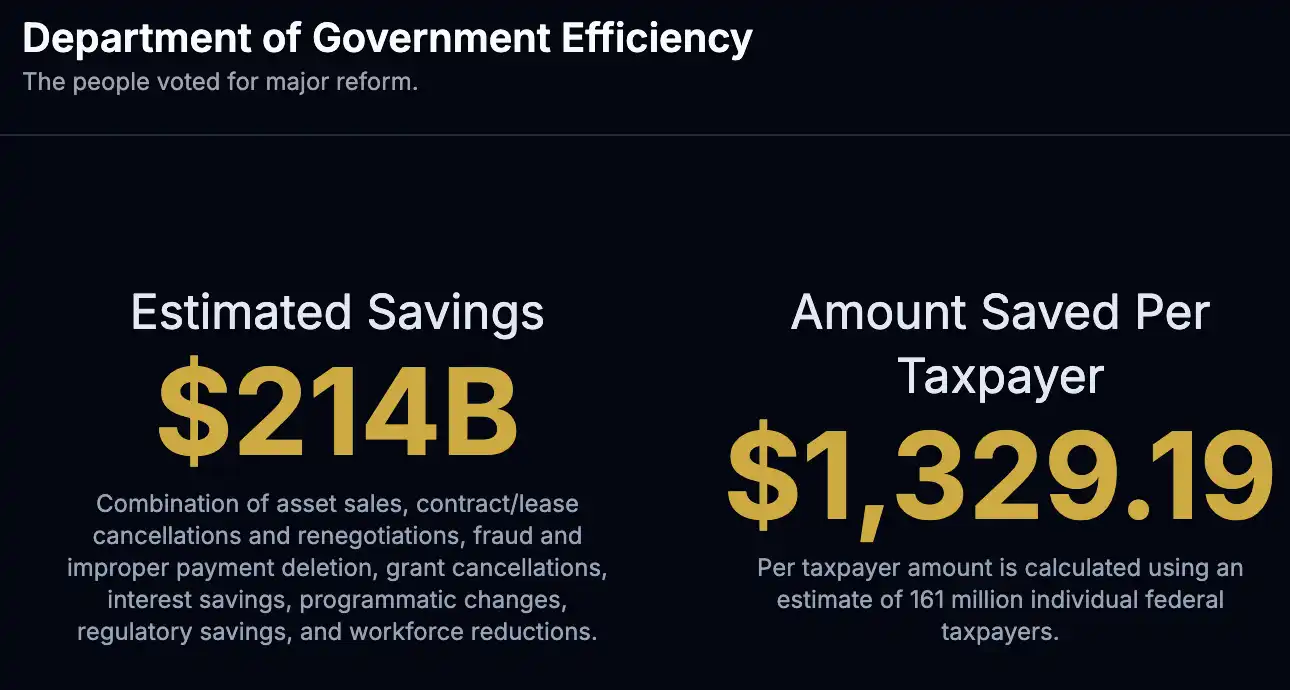What Is DOGE Doing Now That It Hasn’t Disbanded?
Reuters’ report that the U.S. Department of Government Efficiency (DOGE) had been dissolved was actually misinformation.
On November 23, Reuters cited Scott Kupor, Director of the U.S. Office of Personnel Management (USOPM) and a senior Trump administration official, as confirming the news. The story quickly spread and sparked widespread controversy. Reuters portrayed DOGE’s gradual decline as a stark contrast to months of aggressive government promotion: Trump, his advisors, and cabinet members had championed DOGE on social media in its early days, and Elon Musk even famously wielded a chainsaw to highlight the department’s efforts to cut government jobs.
However, the situation quickly shifted. The seemingly explosive report soon sparked controversy and prompted multiple clarifications.

DOGE responded on Twitter, calling the story fake news.
After publication, Scott Kupor—named as the source confirming the news—swiftly challenged Reuters on social media, accusing the outlet of “cleverly editing” his full remarks to generate a sensational headline.
In his tweet, Kupor clarified: “DOGE’s principles remain and continue to operate effectively: deregulation, elimination of fraud, waste, and abuse, reshaping the federal workforce, prioritizing efficiency, and more. DOGE has catalyzed these changes.” He added, “The reality is: DOGE may not have achieved centralized leadership under @USDS. But DOGE’s principles persist and remain effective.”

Reuters’ “Fake News”: The Push to Dissolve DOGE Never Stopped
Reuters, a globally recognized news agency, serves clients worldwide and is expected to maintain neutrality. Yet, in the U.S., conservative audiences often perceive Reuters as left-leaning. The early coverage of DOGE’s dissolution has fueled debate over whether the report was objective or driven by bias.
Several signs suggest the report reflected deeper dynamics. First, establishment figures and traditional media have long viewed DOGE—a disruptor—with skepticism and may have emphasized its “dissolution” to diminish its influence. Second, Washington’s political circles have been hostile to Musk and DOGE, using media coverage to declare its failure.
Public speculation is not without basis.
Since its inception, DOGE was destined to face opposition from all sides. The department’s existence challenged Washington’s power structure, threatening entrenched interests and provoking fierce resistance.
Protesters gathered outside the Office of Personnel Management, alleging that Musk had illegally seized control of government infrastructure and expressing concerns that a foreign-born, unelected individual might steal sensitive federal data. Federal employees, retirees, and others angered by Musk and DOGE organized rallies in front of the Treasury Department. Twenty-one U.S. Digital Service (USDS) staff resigned en masse. These internal protests highlighted the strong pushback from government workers against DOGE’s aggressive policies.
Multiple polls indicated that most Americans opposed DOGE’s overhaul of government and Musk’s expanded authority. Musk revealed in a cabinet meeting that his Government Efficiency Department team received daily death threats.

Although Musk left Washington after a public dispute with Trump in May, Trump administration officials never confirmed DOGE’s dissolution. Nonetheless, rumors and signals about DOGE’s demise have persisted.
For instance, Scott Kupor, the so-called “mistaken whistleblower” in this episode, has no direct evidence of public conflict with Musk or DOGE, but has openly criticized DOGE’s approach.
Who Is the “Mistaken Whistleblower” Scott Kupor?
Scott Kupor may be an unfamiliar name to many, but he previously served as managing partner at Andreessen Horowitz (a16z), a prominent Silicon Valley venture capital firm. On July 14, 2025, Kupor was sworn in as Director of the U.S. Office of Personnel Management.
Upon taking office, Kupor introduced modernized hiring reforms, replacing the traditional “choose one of three” model with a broader talent pool selection process. His goal was to recruit from a wider range of candidates. He also prioritized making OPM more efficient and transparent, actively attracting tech talent—especially those with AI expertise—into the federal government.
During media interviews, Kupor stated, “OPM is its own agency.” He explained that he would collaborate with DOGE if their goals aligned, but would never fully follow DOGE’s directives. In other words, he aimed to institutionalize efficiency reforms, but rejected Musk’s radical methods.
Previous reports confirm Kupor’s disagreements with DOGE. The Financial Times noted his criticism of Musk’s management systems, such as mandatory “weekly progress reports.” The Washington Post reported that Kupor found Musk’s “5 Things Weekly Report” system inefficient. Regarding Musk’s aggressive cost-cutting goals, Kupor expressed skepticism: “We can’t save $2 trillion just by zeroing out all discretionary spending.”
Kupor’s incremental reform philosophy stands in sharp contrast to Musk’s aggressive layoffs. He likely believes that reforming through a traditional agency like OPM is more stable and sustainable than relying on outside consultants like Musk. Despite his criticism, Kupor acknowledged DOGE’s catalytic impact.
According to Kupor and Reuters’ disclosures, OPM has now assumed much of DOGE’s cost-cutting and downsizing responsibilities. As the federal government’s HR department, OPM is naturally suited to these tasks. Kupor’s statements may signal a shift within the Trump administration: phasing out the controversial, Musk-led independent agency and consolidating reform into standard government departments, allowing reforms to continue while reducing external scrutiny.
What Is DOGE’s “Report Card”?
At a Trump campaign rally in Madison Square Garden last October, Musk claimed DOGE could cut “at least” $2 trillion in federal spending—more than the 2023 discretionary budget.
At the first cabinet meeting this February, Musk remained optimistic, estimating $1 trillion in cuts—15% of the budget.
But as time passed, these targets repeatedly shrank. By April 2025, Musk claimed $150 billion had been cut, a figure disputed by fact-checkers. On June 5, House DOGE caucus leader Blake Moore said Republicans always knew this was “a massive exaggeration.”
According to DOGE’s website, the department canceled 13,440 contracts, 15,887 grants, and 264 leases—figures that fluctuated sharply over its 10-month existence. DOGE pledged to save taxpayers $1 trillion, but even by its own accounting, it fell far short.
At publication, DOGE’s website claims the department saved $214 billion through “asset sales, contract/lease cancellations and renegotiations, fraud and improper payment eliminations, grant cancellations, interest savings, project changes, regulatory savings, and layoffs”—equivalent to $1,329.19 per taxpayer.

This is far short of the original $1 trillion goal, amounting to only about 21%. Since the agency has not released detailed work accounts, outside financial experts cannot verify the claims. After the fiscal year closed in October, The New York Times reported that budget experts and the Congressional Appropriations Committee still did not know how much money was cut or where the unspent funds went.
In a recent tweet, DOGE said that in the past nine days, it had canceled or reduced 78 wasteful contracts totaling $1.9 billion, saving $335 million.

These included a $616,000 HHS IT services contract for a “social media monitoring platform subscription”; a $191,000 USAGM broadcasting contract for “broadcast operations and maintenance in Ethiopia”; and a $4.3 million IRS IT services contract for “Inflation Reduction Act transformation project management support.”
Previously, DOGE’s “achievements” were mainly in staff reductions and disrupting agency operations.
DOGE began its federal downsizing by eliminating all employees involved in diversity, equity, and inclusion work across federal agencies, putting them on administrative leave.
Next, DOGE announced a voluntary “deferred retirement” program, called “Fork in the Road,” allowing federal employees to resign but continue receiving pay through September—nearly 75,000 accepted the offer in February. Related reading: “Another Multi-Million Dollar Contract Cut: What Odd Government Departments Has Musk’s D.O.G.E. Found?“
The second Trump administration announced about 300,000 federal civil servant layoffs, nearly all attributed to DOGE. As of July 14, 2025, CNN tracked at least 128,709 workers laid off or targeted for layoffs. By May 12, The New York Times had tracked over 58,500 confirmed cuts, more than 76,000 buyouts, and over 149,000 other planned reductions; in total, these accounted for 12% of the 2.4 million civilian federal workforce.
In a Friday blog post on federal personnel plans, Kupor said the government had hired about 68,000 people this year, while 317,000 employees left—surpassing Trump’s goal of cutting four for every one hired.
By department: The Department of Education will cut nearly 50% of its staff. Over 1,300 positions will be eliminated through RIF, plus about 600 who accepted the “Fork” deferred resignation or the department’s VSIP offer. The Department of Veterans Affairs aims to “return to our 2019 final strength of 399,957 employees,” a reduction of about 80,000. The Department of Health and Human Services plans to cut 20,000 positions (25% of the agency), half through early retirement, buyouts, and attrition.
DOGE is the driving force behind many federal staff reductions this year. Government agencies made up most of these layoffs, with 62,530 federal workers dismissed in the first two months of 2025—a staggering 41,311% increase over the same period in 2024.
It’s no surprise that rumors of DOGE’s “dissolution” have surfaced, as many hope to see the disruptive agency disappear from Washington’s power structure.
For now, DOGE’s story may not be over.
Statement
- This article was reprinted from [BlockBeats], with copyright belonging to the original author [Jaleel Jia Liu]. If you have concerns regarding this reprint, please contact the Gate Learn team, and they will address the issue according to established procedures.
- Disclaimer: The views and opinions expressed in this article are solely those of the author and do not constitute investment advice.
- Other language versions of this article were translated by the Gate Learn team. Unless Gate is specifically cited, do not copy, distribute, or plagiarize these translated articles.
Related Articles

Reflections on Ethereum Governance Following the 3074 Saga

Gate Research: 2024 Cryptocurrency Market Review and 2025 Trend Forecast

Gate Research: BTC Breaks $100K Milestone, November Crypto Trading Volume Exceeds $10 Trillion For First Time

NFTs and Memecoins in Last vs Current Bull Markets

Altseason 2025: Narrative Rotation and Capital Restructuring in an Atypical Bull Market
